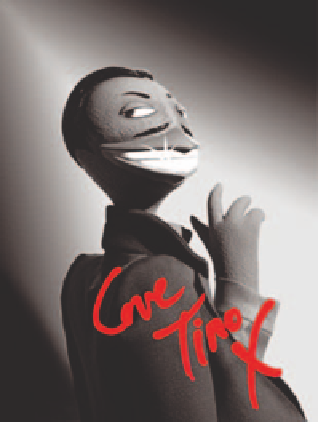Graphics Reference
In-Depth Information
It's interesting to see the photos of Pal at work, with his immaculately dressed animators wearing
laboratory coats, signii cantly looking more like technicians than animators. I can't begin to think
of the coordination and planning such shoots must have taken, but for the animators it can't
have been much fun. Although they were still touching the puppets, they weren't getting that
all-important and satisfactory tactile pleasure of feeling the puppets actually move. I'm all in
favour of good armatures that allow the animator to choose a size of movement that feels right
at that instant. Whenever I've worked with replacements, there never seems to be the shape or
position that I want. Again, for me, it's all about trying to keep a feeling of spontaneity, but then,
for some of the massed ranks of Pal's characters the very important ef ect was the lack of this
spontaneity. With a producer's hat briel y (a hat that doesn't i t me), it would terrify me to have
to build a replacement puppet, however simple, and only use it for a few frames.
The more satisfying use of replacements is when they
are just an element of the puppet, such as in
Creature
Comforts, The Nightmare Before Christmas, James
and the Giant Peach
, Tino in
Hamilton Mattress
and
many other i lms. There's usually a fully articulated
main puppet which allows the necessary range of
performance, but with a mouth, or even a whole face
that is replaceable by other pieces, giving extreme
shapes that an internal armature might not manage.
This all depends on the director and how much
emphasis he wants to put on the mouth and facial
performance. The areas next to the sets are littered
with well-labelled boxes of replacement mouth
shapes or eyebrows. Making replacements tests the
skills of the puppet makers, as the joins have to be
carefully hidden or disguised as part of the design.
They must i t perfectly as otherwise there will be
unpleasant twitching. For the animator the actual
replacing of the bits can be i ddly. The replacements
are usually held in position by a combination of rods
and magnets, but sometimes, in the middle of a shot, the puppet may be in such a position in
the set that there is little room to pull of the face. A lot of planning has to go into working with
replacements, which is why I like fully armatured puppets. I would prefer to do the storytelling
with the body rather than the face.
The lugubrious Tino from
Hamilton
Mattress
, whose mouth was a series of
replacements.
Armatured puppets suit the style of animation and the detailed performance I try to achieve.
It may not be realistic, but it allows me to be elegant, detailed, complex, l orid and subtle.



Search WWH ::

Custom Search